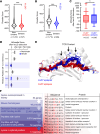Posttranslationally modified self-peptides promote hypertension in mouse models
- PMID: 39145457
- PMCID: PMC11324298
- DOI: 10.1172/JCI174374
Posttranslationally modified self-peptides promote hypertension in mouse models
Abstract
Posttranslational modifications can enhance immunogenicity of self-proteins. In several conditions, including hypertension, systemic lupus erythematosus, and heart failure, isolevuglandins (IsoLGs) are formed by lipid peroxidation and covalently bond with protein lysine residues. Here, we show that the murine class I major histocompatibility complex (MHC-I) variant H-2Db uniquely presents isoLG-modified peptides and developed a computational pipeline that identifies structural features for MHC-I accommodation of such peptides. We identified isoLG-adducted peptides from renal proteins, including sodium glucose transporter 2, cadherin 16, Kelch domain-containing protein 7A, and solute carrier family 23, that are recognized by CD8+ T cells in tissues of hypertensive mice, induce T cell proliferation in vitro, and prime hypertension after adoptive transfer. Finally, we find patterns of isoLG-adducted antigen restriction in class I human leukocyte antigens that are similar to those in murine analogs. Thus, we have used a combined computational and experimental approach to define likely antigenic peptides in hypertension.
Keywords: Antigen; Cardiology; Hypertension; Immunology; MHC class 1.
Conflict of interest statement
Figures







References
MeSH terms
Substances
Grants and funding
LinkOut - more resources
Full Text Sources
Medical
Molecular Biology Databases
Research Materials

